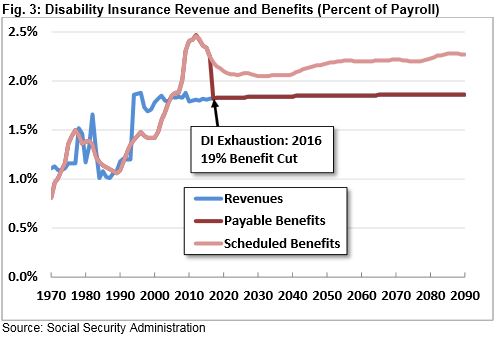CRFB Breaks Down the Social Security Trustees' Report
Following the release of the 2015 Social Security Trustees' report yesterday, CRFB has released a report summarizing the myriad statistics and projections that the Trustees published. Our report discusses the solvency of both the disability and old-age portions of the program, the long-term shortfall of the program, and how the projections changed since last year.
The report shows a similar, though slightly improved, outlook to last year for the program. The Social Security Disability Insurance (SSDI) trust fund is still projected to be exhausted in late 2016, leading to a 19 percent cut in benefits. The insolvency dates for the old-age and combined trust funds have been pushed back one year to 2035 and 2034, respectively, at which point benefits would be cut by 21 percent for all beneficiaries. The program faces a 2.68 percent of payroll shortfall, or 0.96 percent of Gross Domestic Product (GDP), that lawmakers must close to ensure solvency over the next 75 years.
Click here to read the full paper.
As our report explains, these financial issues are the result of an already-existing and widening gap between spending and revenue.
As the number of beneficiaries in the program continues to grow, outlays have already increased from 10.4 percent of payroll (4.0 percent of GDP) in 2000 to 14.1 percent of payroll (5.0 percent of GDP) today. The Trustees project they will continue to grow to 16.7 percent of payroll (6.0 percent of GDP) by 2040, dip slightly, and then grow to 18.0 percent of payroll (6.2 percent of GDP) by 2090.
Meanwhile, revenues will fail to keep up – growing slightly as a percent of payroll from 12.8 percent today to 13.3 percent in 2090, while actually falling slightly as a percent of GDP after the 2020s from 4.8 percent in 2030 to 4.6 percent by 2090.
Of particular concern is the soon-to-be-insolvent SSDI program, which is one of the Fiscal Speed Bumps that must be dealt with this Congress. As we explain, averting the trust fund's insolvency next year will likely require some form of transfer from the old-age trust fund, since the changes required otherwise would be too disruptive. But lawmakers should take the opportunity to make financial and policy improvements to the program – and ideally to the entire Social Security program – in conjunction with any transfer.
The Trustees' report clearly shows the need to act on Social Security now, whether it is to shore up SSDI or the program at large. The longer lawmakers wait to make changes, the bigger and more sudden changes will need to be put its finances in order, as we explained in Updating the Cost of Delay for Social Security.
We are already seeing the difficulty of waiting until the deadline with SSDI, where it is already virtually impossible to make changes avoid insolvency without a large cash infusion. Policymakers should act soon so the larger program does not have the same fate.
To read more about the changes in this year's report compared to last year's and other aspects of the Trustees' report, read our analysis.


